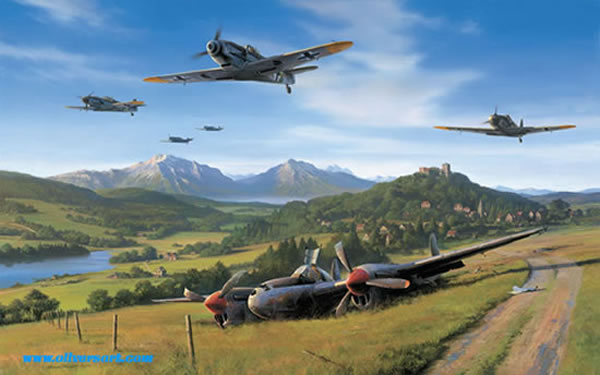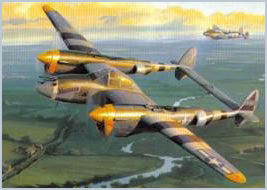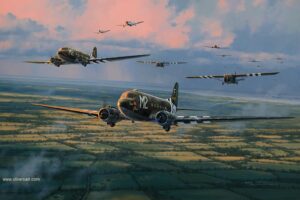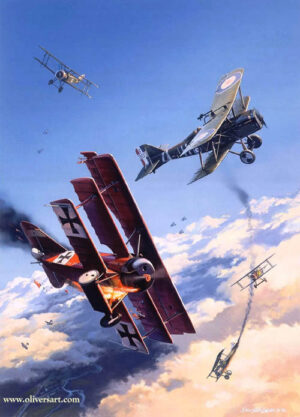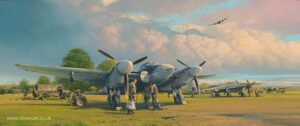Description
Aircraft – Me 109G’s, P-38
A spectacular painting paying tribute to the courage and resolve of the Luftwaffe fighter pilots of World War Two, all of whom flew combat without respite, some surviving more than five years of continual air fighting to record thousands of combat missions
Nobody, least of all Allied aircrew, ever doubted the tenacity of the Luftwaffe, more particularly that of the German fighter pilots. From the early encounters during the Battle of Britain to the great air battles in defence of their homeland late in the war, at all times they were held in high regard, even if resented as a foe. At no time was their dedication, determination and courage better demonstrated than during the final stages of World War Two.
By the summer of 1944 the Allies had gained a foothold in Normandy, and total air supremacy above Northern France. German installations and ground positions were being pounded every day from the air, and the Ruhr, the heartland of industrial Germany, was under constant siege. Even the factories in southern Germany were not safe from the attentions of the USAAF bombers by day and the RAF by night. But in spite of the pressures of mounting losses and diminished supplies, the Luftwaffe fought doggedly on in the best traditions of the fighter pilot.
The morning of 19 July 1944 saw the USAAF’s 8th and 15th Air Forces mount an attack of awesome proportion against the aircraft factories in the region of Munich. To combat a seemingly overwhelming force of 1400 bombers and almost s many fighter escorts, the Luftwaffe were able to put up just three Gruppen from JG300 and one from JG302, flying a mix of Me109G’s and Fw190’s – barely 50 serviceable fighters between them. They were joined by a dozen Me109’s of II./JG27, these fighters desperately trying to defend the very factories in which they were made.
In a beautiful and symbolic painting, Nicolas Trudgian shows the Messerschmitt Me109G’s of II./JG27, sporting their sage green ‘Defence of the Reich’ markings, returning to base at Fels am Wagram after a ferocious combat fought on that warm summer day. A P-38 Lightning, ONE OF 47 Allied aircraft brought down during the air fighting, lies crash-landed in spectacular Bavarian Countryside, testimony to the fact that this is still very much ‘Messerschmitt Country,
Overall print size: 31¾” wide x 23½”high
Signed by the artist and three of the Luftwaffe’s top Me109 fighter Aces
Oberleutnant Siegfried Bethke – joined the Luftwafffe in 1935 and was posted to II.JG/2 shortly before the Battle of France. During the Battle of Britain he was Staffelkapitan of 2./JG2, and by the end of 1940 his tally of victories had reached 10. He later flew on the famous Channel Dash operation, but a serious accident soon after halted his flying career. He was awarded the Iron Cross 1ST and 2nd Class, he had a total of 14 victories.
Oberleutnant Gunther Seeger – In February 1940 Gunther Seeger was an Unteroffizier with 3./JG2, scoring his first victory in the early days of the Battle of Britain. He served on the Channel Front until December 1942, including several months with the Gestwaderstabs-schawm. He transferred to the Mediterranean theatre with II./JG53. In February 1943 he joined 7./JG53, becoming Staffelkapitan in September 1944. Awarded the Knight’s Cross, Gunther Seeger scored 56 victories.
Oberleutnant Ernst Scheufele – joining the Luftwaffe in October 1940, he was posted to Norway in June 1942, to join 4./jg5. There, flying Me109s he carried out a total of 67 escort missions for the German battleships Bismarck and Tirpitz. In October 1943 he joined II./JG5 flying over Arctic waters, in Finland, and on the Russian Front, before transferring to the defence of the Reich in June 1944. On 3 December 1944 he was shot down by an American flak battery near Saxony, wounded and taken prisoner. He had a total of 18 victories
All editions are issued with a matching numbered companion print ‘Kings Cliffe Lightning’, signed by:
Colonel Darrell G Welch – Commissioned in 1941 he was assigned to the 27th Squadron of the1st Fighter Group, which became the first Squadron to be equipped with the new P38 Lightning. Arriving in England in August 1942, the 1st Fighter Group was part of a large American force despatched to Algiers in November for the North African campaign, where he made his first kill in January 1943 while escorting B17s over Tripoli. A few months later, whilst leading the 27th on a big intercept mission, Welch became an Ace when he notched up his tally to 5 confirmed victories. He later saw service in the Pacific, and retired the service in 1970
Kings Cliffe Lightning’
A P-38 Lightning from the 20th Fighter Group based at King Cliffe, England, during the summer of 1944. The Lightning, with its radical twin engine, twin boom design, dubbed by the Germans ‘ the fork-tailed devil’, was one of the toughest, hard hitting and most versatile fighters of its day.
Overall print size:11½” wide x 9″ high

